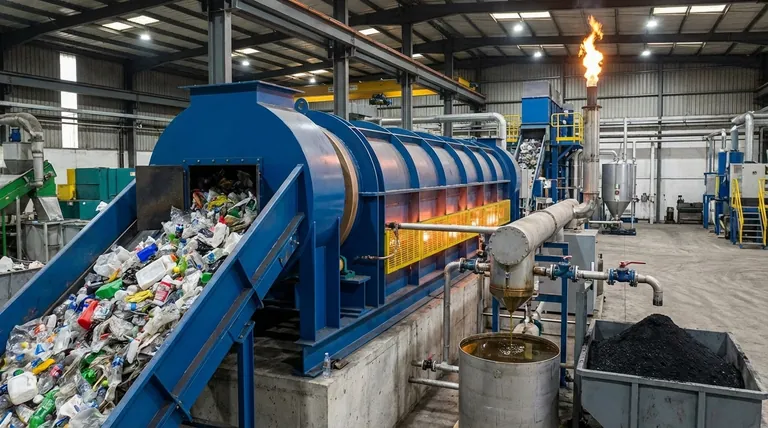At its core, the primary benefit of plastic pyrolysis is its ability to transform waste material with little to no value into valuable resources. It achieves this by chemically decomposing plastics in the absence of oxygen, drastically reducing the volume of waste sent to landfills and creating marketable products like synthetic gas, oil, and char.
Pyrolysis should be understood not as mere waste disposal, but as a form of chemical recycling. It provides a pragmatic solution for complex plastic streams that cannot be handled by traditional mechanical recycling, turning an environmental liability into a potential asset.

The Core Benefit: Turning Waste into Value
Pyrolysis attacks the plastic waste problem on two fronts: it significantly reduces the volume of waste requiring disposal and simultaneously creates new, usable materials from that waste.
Drastic Reduction in Landfill Volume
The most immediate environmental benefit is the significant diversion of plastic from landfills. This process can reduce the original volume of solid waste substantially, alleviating pressure on landfill capacity.
Creation of Usable Energy Products
The process breaks down long polymer chains into smaller, more useful molecules. This yields two key energy products.
First is syngas (synthesis gas), a fuel gas that can be used to generate heat and power, often to sustain the pyrolysis process itself, reducing external energy needs.
Second is pyrolysis oil (or bio-oil), a liquid fuel that can be refined and used in engines, boilers, or as a feedstock for producing new chemicals and plastics.
Production of a Valuable Solid Byproduct
The solid residue left after the process is a carbon-rich material called bio-char.
This material has direct applications as a soil amendment to improve soil health or can serve as a raw material for producing high-value activated carbon, which is used in filtration and purification systems.
A Solution for "Unrecyclable" Plastics
Perhaps the most significant advantage of pyrolysis is its ability to handle plastic waste streams that are notoriously difficult or impossible to manage through conventional mechanical recycling.
Handling Mixed and Contaminated Streams
Mechanical recycling requires clean, well-sorted streams of a single type of plastic. Pyrolysis is far more tolerant, capable of processing mixed plastics, including those contaminated with residues like PET/PVC.
Processing Complex Packaging
Modern packaging often involves multi-layer plastics, where different materials are bonded together. These are a major headache for mechanical recycling but can be effectively broken down through pyrolysis.
Complementing Mechanical Recycling
Pyrolysis is not necessarily a replacement for traditional recycling but a powerful complement. It can process the "reject" material from mechanical sorting facilities, creating a more comprehensive and robust overall waste management system.
Understanding the Trade-offs and Challenges
While beneficial, pyrolysis is an industrial process with inherent complexities and challenges that must be managed for it to be a truly sustainable solution.
Energy Input Requirements
The process requires heating plastic waste to high temperatures, which is an energy-intensive operation. The net energy benefit depends heavily on efficiently using the syngas produced to help power the facility.
Emissions and Environmental Controls
Heating mixed plastics can release various compounds. A successful pyrolysis plant depends on a sophisticated and robust system for capturing and treating off-gases to prevent air pollution and ensure safe operation.
Quality and Consistency of Outputs
The composition of the input plastic waste directly impacts the quality and chemical makeup of the resulting oil, gas, and char. Managing feedstock variability is a constant operational challenge to ensure the final products meet market specifications.
How to Evaluate Pyrolysis for Your Goal
Adopting pyrolysis is a strategic decision that depends on your primary objective.
- If your primary focus is waste volume reduction: Pyrolysis is an extremely effective technology for diverting large quantities of non-mechanically recyclable plastic from landfills.
- If your primary focus is creating a circular economy: This process provides a viable chemical recycling pathway, converting waste plastic polymers back into fuel or chemical feedstocks.
- If your primary focus is energy generation: Pyrolysis effectively transforms plastic waste, which has a high energy content, into a localized source of fuel for heat and power.
Ultimately, pyrolysis represents a powerful tool for waste management, offering a pragmatic solution for converting problematic plastic streams into valuable resources.
Summary Table:
| Benefit | Key Outcome |
|---|---|
| Waste Reduction | Drastically cuts landfill volume |
| Energy Creation | Produces syngas and pyrolysis oil for fuel |
| Resource Recovery | Generates valuable bio-char for soil or activated carbon |
| Handles Complex Waste | Processes mixed, contaminated, and multi-layer plastics |
Ready to transform your plastic waste into valuable resources? KINTEK specializes in advanced lab equipment and consumables for pyrolysis research and development. Whether you're analyzing feedstock, optimizing processes, or testing output quality, our solutions help you build a more sustainable and profitable waste management system. Contact our experts today to find the right equipment for your pyrolysis goals!
Visual Guide

Related Products
- Electric Rotary Kiln Pyrolysis Furnace Plant Machine Calciner Small Rotary Kiln Rotating Furnace
- Electric Rotary Kiln Continuous Working Small Rotary Furnace Heating Pyrolysis Plant
- Chemical Vapor Deposition CVD Equipment System Chamber Slide PECVD Tube Furnace with Liquid Gasifier PECVD Machine
- Metal Disc Electrode Electrochemical Electrode
- Electrolytic Electrochemical Cell for Coating Evaluation
People Also Ask
- What are the industrial applications of pyrolysis? Transform Waste into Energy and Valuable Products
- What are the types of pyrolysis reactors used in industry? Choose the Right Technology for Your Product
- What is the principle of rotary kiln? Mastering Continuous Thermal Processing
- What biomass is used in pyrolysis? Selecting the Optimal Feedstock for Your Goals
- What is the difference between calcining and roasting? A Guide to High-Temperature Processing



















